Why are my bean plants turning yellow? This is a question many gardeners face, and it can be a frustrating sight to see your once vibrant bean plants losing their lush green color. Bean plant yellowing can be caused by a variety of factors, from nutrient deficiencies to environmental stressors and even pests and diseases.
Understanding the underlying cause is crucial for effectively treating the issue and restoring your bean plants to their former glory.
This comprehensive guide will delve into the common reasons behind bean plant yellowing, providing insights into the symptoms, causes, and solutions. We’ll explore the role of nutrient deficiencies, environmental factors, pests and diseases, and other potential causes. Armed with this knowledge, you’ll be equipped to diagnose the problem accurately and take the necessary steps to revive your bean plants.
Understanding Bean Plant Yellowing
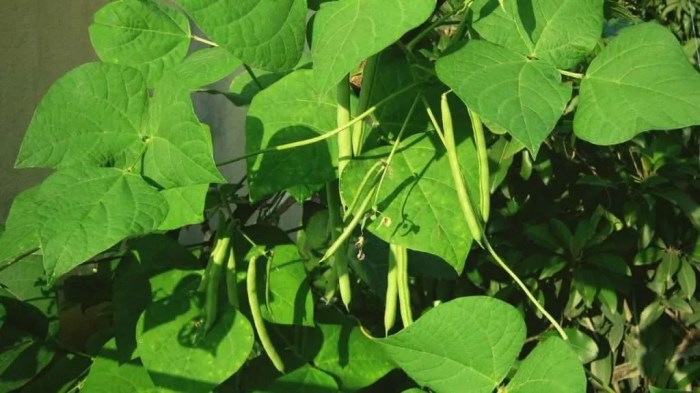
Seeing your bean plants turn yellow can be alarming, but don’t panic just yet. Yellowing leaves are a common symptom of various issues, and understanding the underlying cause is crucial for effective treatment. This guide will explore the common culprits behind bean plant yellowing, helping you diagnose and address the problem.
Identifying the Cause of Yellowing
Understanding the specific cause of yellowing is vital for effective treatment. A variety of factors can contribute to yellow leaves, and misdiagnosis can lead to wasted time and effort. Here’s a breakdown of common causes and their associated symptoms:
| Symptom | Potential Cause | Explanation |
|---|---|---|
| Overall yellowing, stunted growth, wilting | Nutrient deficiency (especially nitrogen) | Beans require ample nitrogen for healthy growth. A lack of nitrogen can lead to a pale yellow color, particularly in older leaves. |
| Yellowing between veins, with veins remaining green | Iron deficiency | Iron is essential for chlorophyll production, which gives plants their green color. Iron deficiency can lead to yellowing between leaf veins, with the veins remaining green. |
| Yellowing of older leaves, with newer leaves remaining green | Magnesium deficiency | Magnesium is vital for chlorophyll production and plays a role in nutrient transport. A deficiency can cause yellowing of older leaves, as the plant prioritizes newer growth. |
| Yellowing of lower leaves, followed by wilting and browning | Root rot | Root rot, caused by fungal infections, damages the roots, preventing them from absorbing water and nutrients. This leads to yellowing, wilting, and eventually, leaf death. |
| Yellowing, followed by wilting and leaf drop | Drought stress | Beans require consistent moisture. Prolonged drought can lead to dehydration, causing yellowing, wilting, and leaf drop. |
| Yellowing, followed by wilting and leaf drop | Overwatering | Overwatering can suffocate roots, preventing them from absorbing water and nutrients, leading to yellowing, wilting, and leaf drop. |
| Yellowing and stunted growth, with brown spots on leaves | Viral infection | Viral infections can cause a variety of symptoms, including yellowing, stunted growth, and brown spots on leaves. |
| Yellowing, followed by wilting and leaf drop | Pests | Pests like aphids and whiteflies can damage plants by sucking sap, leading to yellowing, wilting, and leaf drop. |
Environmental Factors
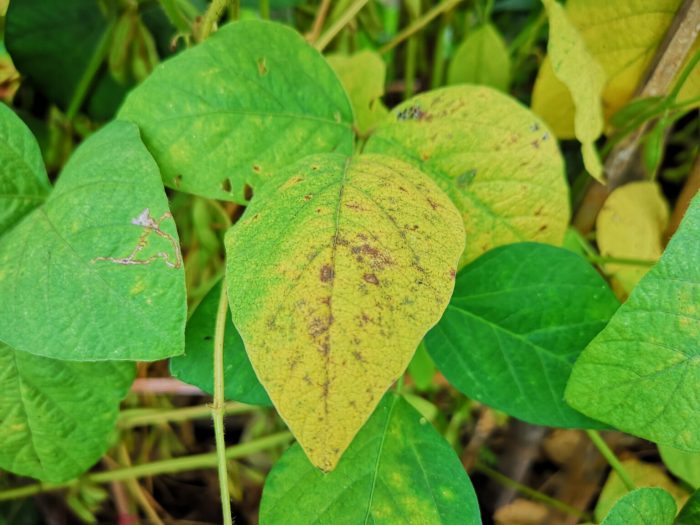
Environmental factors play a crucial role in the health and well-being of bean plants. Sunlight, temperature, and water are essential elements that directly impact their growth and development. Imbalances in these factors can lead to various issues, including yellowing of leaves.
Sunlight
Sunlight is crucial for photosynthesis, the process by which plants convert light energy into chemical energy for growth. Bean plants require a minimum of six hours of direct sunlight per day to thrive. Insufficient sunlight can lead to:* Chlorosis:A condition where leaves lose their green color due to a lack of chlorophyll.
This is often manifested as yellowing of leaves.
Stunted growth
Bean plants may struggle to grow and develop properly without adequate sunlight.
Weak stems
Insufficient sunlight can lead to weak and spindly stems, making the plants more susceptible to damage.Excessive sunlight can also be detrimental to bean plants:* Sunburn:Prolonged exposure to intense sunlight can cause leaf scorching, leading to yellowing and browning of the leaves.
Wilting
Seeing yellowing leaves on your bean plants can be a frustrating sight, especially after all the hard work you put into nurturing them in your backyard. This discoloration often signals a problem, whether it’s a nutrient deficiency, pest infestation, or even improper watering.
Understanding the root cause is key to reviving your bean plants and ensuring a bountiful harvest.
Excessive sunlight can lead to dehydration and wilting, especially during hot weather.
Reduced yield
Excessive sunlight can stress the plants, leading to a reduced yield of beans.
Temperature
Bean plants thrive in warm temperatures, typically between 70°F and 85°F (21°C and 29°C). However, extreme temperatures can significantly impact their growth and health.* Cold temperatures:Bean plants are sensitive to cold temperatures and may experience stunted growth or yellowing of leaves.
Frost can be particularly damaging.
Hot temperatures
High temperatures can lead to wilting, dehydration, and yellowing of leaves. In extreme heat, bean plants may even experience leaf drop.
Water
Water is essential for the growth and development of bean plants. Proper watering is crucial for maintaining their health.* Underwatering:Bean plants require consistent moisture, especially during the initial stages of growth. Underwatering can lead to wilting, stunted growth, and yellowing of leaves.
Overwatering
While bean plants need adequate water, overwatering can be detrimental. It can lead to root rot, which can cause yellowing of leaves and eventually death of the plant.
Inconsistent watering
Fluctuating watering patterns can stress the plants, leading to yellowing of leaves. Consistent watering is key to maintaining healthy bean plants.
Nutrient Deficiencies
Environmental factors can also contribute to nutrient deficiencies, which can cause yellowing of bean plants. For example:* Poor soil drainage:Poor drainage can lead to a buildup of water in the soil, depriving the roots of oxygen and nutrients. This can cause yellowing of leaves due to nutrient deficiencies.
Soil compaction
Compacted soil restricts root growth and limits access to nutrients. This can lead to nutrient deficiencies and yellowing of leaves.
Acidic soil
Bean plants prefer slightly acidic to neutral soil (pH 6.0-7.0). Acidic soil can make it difficult for plants to absorb certain nutrients, leading to yellowing of leaves.
Other Potential Causes
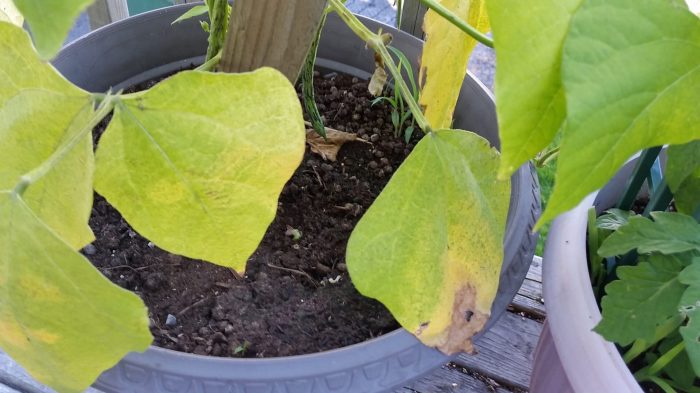
While nutrient deficiencies and environmental factors are common culprits behind yellowing bean plants, other issues can also contribute to this problem. Understanding these additional causes can help you identify the root of the problem and take appropriate steps to restore your plants’ health.
Soil Compaction
Soil compaction can significantly hinder bean plant growth and lead to yellowing. When soil is compacted, it becomes dense and hard, making it difficult for roots to penetrate and access essential nutrients and water. This can result in stunted growth, reduced nutrient uptake, and ultimately, yellowing leaves.
Preventing Soil Compaction
- Avoid excessive foot traffic:Walking on soil, especially when it’s wet, can contribute to compaction. Try to minimize foot traffic in your garden beds.
- Till or loosen soil:Before planting, till or loosen the soil to improve drainage and aeration. You can also use a garden fork or hand cultivator to break up compacted areas.
- Add organic matter:Incorporating organic matter like compost or manure into the soil can improve its structure and reduce compaction. Organic matter acts like a sponge, helping to retain moisture and improve drainage.
Root Damage, Why are my bean plants turning yellow
Damaged roots can disrupt nutrient and water uptake, leading to yellowing leaves. Root damage can occur due to various factors, including:
- Pests:Root-feeding pests like grubs and nematodes can damage root systems, impairing nutrient absorption.
- Improper transplanting:If bean plants are transplanted too deeply or their roots are disturbed during transplanting, it can hinder root growth and nutrient uptake.
- Physical injury:Tools, digging, or other physical disturbances can damage roots, affecting their ability to function properly.
Improper Planting Depth
Planting bean seeds at the correct depth is crucial for healthy growth. If seeds are planted too deep, they may struggle to emerge and their roots may not develop properly. Conversely, if they are planted too shallow, they may be exposed to drying conditions and become vulnerable to pests.
Ensuring Optimal Planting Depth
- Follow seed packet instructions:Seed packets typically provide recommended planting depths for specific bean varieties.
- Consider soil type:In lighter, sandy soils, seeds can be planted slightly deeper than in heavier, clay soils.
- Check for emergence:Monitor the soil surface for signs of emerging seedlings. If they are too deep, gently loosen the soil around them to encourage emergence.
Troubleshooting and Treatment
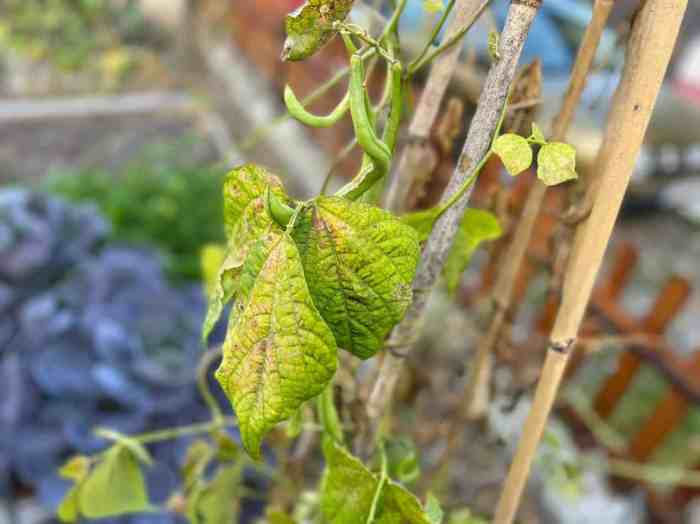
Diagnosing the cause of yellowing in bean plants is crucial for effective treatment. A systematic approach, involving observation, analysis, and potential solutions, can help you identify the underlying issue and address it accordingly.
Diagnosing the Cause of Yellowing
Identifying the cause of yellowing in bean plants requires a careful examination of the plants and their environment. Here’s a step-by-step guide:
- Observe the overall plant health:Are other plants in the garden exhibiting similar symptoms? Are the leaves uniformly yellowed, or are specific areas affected?
- Examine the leaves:Are the leaves wilting, drooping, or curled? Are there any spots, discoloration, or pests present?
- Inspect the soil:Is the soil dry, compacted, or waterlogged? Are there any signs of nutrient deficiencies or pests in the soil?
- Consider the weather conditions:Have there been recent periods of extreme heat, drought, or heavy rainfall?
- Check for root damage:Carefully examine the roots for any signs of disease, pests, or damage.
Addressing Specific Causes of Yellowing
Once you’ve identified the potential cause of yellowing, you can take appropriate steps to address it. The following table Artikels common causes and their corresponding treatments:
| Cause | Treatment | Explanation |
|---|---|---|
| Nutrient Deficiency | Apply a balanced fertilizer specifically formulated for bean plants. | Bean plants require a balanced diet of essential nutrients, including nitrogen, phosphorus, and potassium. Yellowing can indicate a deficiency in one or more of these nutrients. |
| Overwatering | Allow the soil to dry out between waterings. Improve drainage if necessary. | Excess water can suffocate the roots, leading to yellowing and wilting. Ensure the soil is well-draining to prevent waterlogging. |
| Drought | Water the plants deeply and regularly, ensuring the soil is consistently moist but not waterlogged. | Lack of water can stress bean plants, leading to yellowing and wilting. Provide adequate moisture to support healthy growth. |
| Root Rot | Improve drainage and avoid overwatering. Consider repotting the plants in fresh, well-draining soil. | Root rot is a fungal disease that can damage the roots, preventing them from absorbing nutrients and water, resulting in yellowing. |
| Pests | Identify the specific pest and use appropriate control measures, such as insecticidal soap or neem oil. | Pests can damage the leaves and roots, leading to yellowing. Monitor for signs of pests and take action to control them. |
| Disease | Remove and destroy infected plants. Consider using a fungicide or bactericide, depending on the specific disease. | Fungal and bacterial diseases can cause yellowing and other symptoms. Promptly address any signs of disease to prevent its spread. |
Monitoring Bean Plants Regularly
Regular monitoring of bean plants is essential for early detection of yellowing and other problems. Early intervention can significantly increase the chances of successful treatment and prevent further damage. Look for changes in leaf color, shape, and texture, as well as any signs of pests or diseases.
Closure: Why Are My Bean Plants Turning Yellow
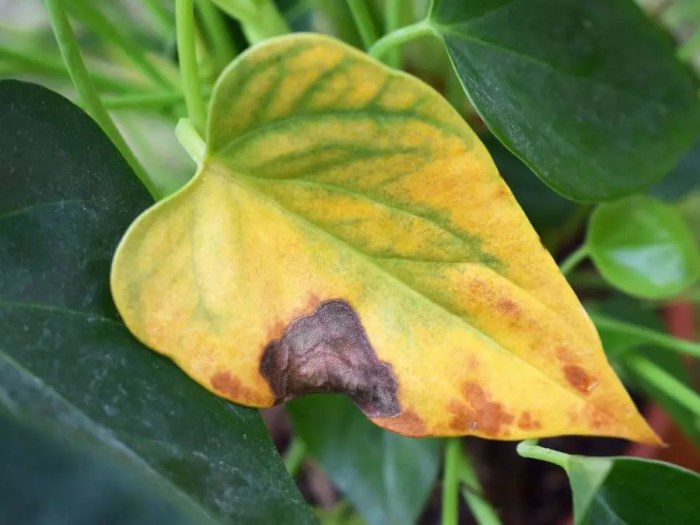
By understanding the various factors that can contribute to bean plant yellowing, you can proactively monitor your plants and take appropriate action to prevent and address issues. Whether it’s addressing nutrient deficiencies, optimizing environmental conditions, or managing pests and diseases, the key lies in early detection and prompt intervention.
With a little care and attention, you can ensure your bean plants thrive and provide you with a bountiful harvest.